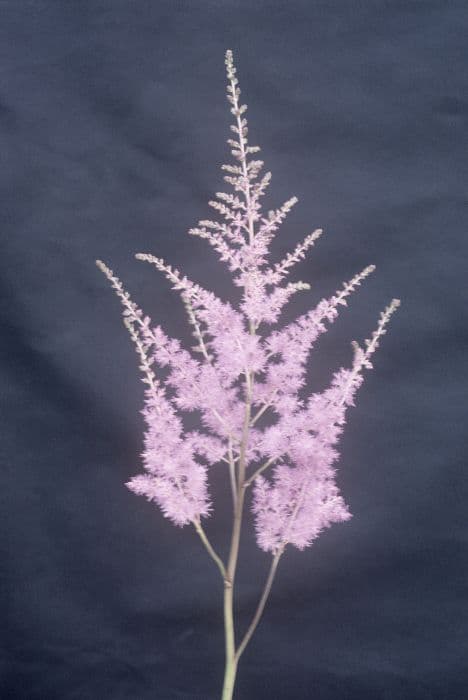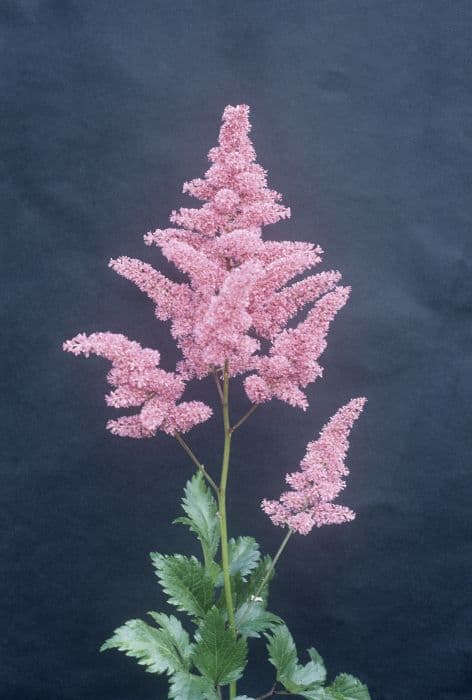Coral Bells Heuchera 'Amethyst Myst'

ABOUT
Heuchera 'Amethyst Myst' is a visually striking plant prized for its unique foliage and delicate blooms. This particular cultivar is characterized by its vibrant leaves, which boast an alluring shade reminiscent of amethyst. The leaves have an almost metallic sheen with deep purple hues that can seem iridescent in the right light, overlaid with a mist-like silver veining that creates a mystical appearance. These round, scallop-edged leaves grow in a mounding habit, creating a lush, full-bodied texture in the garden. During the blooming period, Heuchera 'Amethyst Myst' produces slender stems that rise above the foliage, each bearing a series of small, bell-shaped flowers. These blooms are typically an understated pale pink or white color, providing a delicate contrast to the dramatic, richly colored leaves below. Despite its bold leaf colors, the plant retains a sense of softness and romanticism, especially when the flowers sway gently in the breeze. Its overall appearance makes it a popular choice for gardeners looking to add contrast and depth to their planting schemes.
About this plant
 Names
NamesFamily
Saxifragaceae
Synonyms
Coral Bells, Alumroot
Common names
Heuchera 'Amethyst Myst'.
 Toxicity
ToxicityTo humans
The Coral Bells plant, which includes the variety Heuchera 'Amethyst Myst', is generally considered non-toxic to humans. It is not known to contain any compounds that are harmful upon ingestion, and there are no common reports of poisoning from consuming this plant. If you suspect poisoning from any plant, it is important to consult a medical professional.
To pets
Coral Bells, the common name for Heuchera 'Amethyst Myst' and its related varieties, are typically safe for pets and are not known to be toxic to cats or dogs. There are generally no symptoms of poisoning linked to the ingestion of this plant by pets. However, individual animals may have different sensitivities, and consuming any plant material may cause mild stomach upset in some pets. If you notice any unusual symptoms in your pet after ingestion, it is best to contact a veterinarian.
 Characteristics
CharacteristicsLife cycle
Perennials
Foliage type
Evergreen
Color of leaves
Mixed
Flower color
White
Height
1 feet 4 inches (40 cm)
Spread
1 feet 4 inches (40 cm)
Plant type
Herb
Hardiness zones
4
Native area
North America
Benefits
 General Benefits
General Benefits- Drought Tolerant: Can survive with minimal water, making it suitable for xeriscaping or regions with water restrictions.
- Low Maintenance: Requires little care beyond occasional watering and trimming, saving time and effort.
- Pest Resistant: Naturally resistant to many pests, reducing the need for chemical treatments.
- Attracts Pollinators: Flowers can attract butterflies and bees, beneficial for pollination of nearby plants.
- Year-Round Interest: Provides visual interest throughout all seasons, with evergreen or semi-evergreen foliage.
- Easy to Propagate: Can be easily propagated from cuttings or division, allowing gardeners to expand their collection.
- Soil Erosion Control: Helps prevent soil erosion with its root system in sloped or problematic areas.
- Wide Climate Range: Adaptable to a variety of climates, enabling it to thrive in different environments.
 Medical Properties
Medical PropertiesThis plant is not used for medical purposes.
 Air-purifying Qualities
Air-purifying QualitiesThis plant is not specifically known for air purifying qualities.
 Other Uses
Other Uses- Photography Subject: Heuchera 'Amethyst Myst', with its striking foliage, can be an excellent subject for botanical photography, which can be used for wall art or in calendars.
- Craft Projects: The leaves can be pressed and used in creating personalized bookmarks or in scrapbooking for their unique color and texture.
- Edging Plant: Due to its compact growth habit, Heuchera 'Amethyst Myst' can be used as a living edging along walkways or flower beds.
- Educational Tool: This plant can be used in educational settings, such as schools or botanical gardens, to teach about plant propagation and hybridization.
- Container Combinations: In container gardening, Heuchera 'Amethyst Myst' can be paired with contrasting plants to create visually appealing arrangements.
- Fairy Gardens: The plant's small stature and colorful leaves make it a whimsical addition to miniature fairy gardens.
- Theme Gardens: It can be included in a purple-themed garden design, which emphasizes plants with purple leaves or flowers.
- Seasonal Displays: Can be used in seasonal displays like fall arrangements with pumpkins and gourds due to its autumnal leaf hues.
- Culinary Garnish: While not commonly known for culinary use, the leaves could potentially be used as a colorful, edible garnish for plating dishes.
- Jewelry Inspiration: The intricate patterns on the leaves can inspire designs in jewelry making, such as textures for metal or glass pieces.
Interesting Facts
 Feng Shui
Feng ShuiThe Heuchera is not used in Feng Shui practice.
 Zodiac Sign Compitability
Zodiac Sign CompitabilityThe Heuchera is not used in astrology practice.
 Plant Symbolism
Plant Symbolism- Enduring Beauty: The Heuchera 'Amethyst Myst', commonly known as Coral Bells, typically symbolizes enduring beauty due to its attractive foliage that remains vibrant throughout the seasons.
- Diversification: With its variety of colors and adaptability, Coral Bells represent diversification, showing how different elements can come together to create something beautiful.
- Bewitchment: The name 'Amethyst Myst' suggests a sense of enchantment, making the plant a symbol of bewitchment or charm.
- Balance: The perennial nature of Coral Bells, along with its ability to thrive in both sun and shade, contributes to its symbolism of balance and harmony in life.
- Inviting Positive Energy: Coral Bells are said to welcome positive energy into a garden space, due to their lush foliage and delicate bell-shaped flowers.
 Water
WaterCoral Bells should be watered deeply and thoroughly once a week, allowing the soil to dry out slightly between waterings. Water at the base of the plant to avoid wetting the foliage, which can lead to fungal diseases. To ensure proper hydration, provide about one gallon of water per plant during each watering session. During extremely hot and dry periods, you may need to water more frequently, but always check the soil moisture first to prevent overwatering.
 Light
LightCoral Bells thrive best in partial to full shade, especially in areas with hot summers. They can tolerate morning sun but should be protected from harsh afternoon rays. Ideally, place them in a location that receives dappled sunlight throughout the day to maintain the vibrancy of their foliage.
 Temperature
TemperatureCoral Bells are hardy and can tolerate a range of temperatures, with an ideal growing condition between 60 and 70 degrees Fahrenheit. They can withstand minimum temperatures down to -25 degrees Fahrenheit, but they perform poorly in extremely high temperatures, particularly if they're exposed to direct sunlight.
 Pruning
PruningCoral Bells benefit from pruning to remove any damaged or dead foliage and to promote better air circulation. Prune in the spring to tidy up the plant and encourage new growth. Deadheading, or removing spent flower stalks, can be done as needed throughout the growing season to keep the plant looking neat.
 Cleaning
CleaningAs needed
 Soil
SoilThe Coral Bells (Heuchera 'Amethyst Myst') thrives best in a well-draining, fertile soil mix with a pH range of 6.0-7.0. A good soil mix for Coral Bells can be made by blending equal parts of garden loam, peat moss or compost, and perlite or coarse sand to ensure adequate drainage and aeration.
 Repotting
RepottingCoral Bells should be repotted every 3 to 4 years or when they outgrow their current container. Gently lift and divide the plants in spring, ensuring not to damage the delicate roots, and then pot them in fresh soil.
 Humidity & Misting
Humidity & MistingCoral Bells prefer moderate humidity levels, but they are quite adaptable and can tolerate a range of conditions. They do not require high humidity environments to thrive, making them suitable for typical household humidity levels.
 Suitable locations
Suitable locationsIndoor
Place Coral Bells in bright, indirect light and ensure good air flow.
Outdoor
Choose a spot with dappled sun and well-drained soil for Coral Bells.
Hardiness zone
4-9 USDA
 Life cycle
Life cycleCoral Bells 'Amethyst Myst' begins its life cycle when seeds are sown or when it is propagated through division in the spring. Germination is followed by the growth of a rosette of leaves close to the ground, which mature and develop the plant's characteristic deep purple or amethyst foliage often with a metallic silver overlay. The plant then produces tall, slender stems with small bell-shaped flowers in late spring to early summer, attracting pollinators such as bees and hummingbirds. After pollination, these flowers may produce seed capsules, which, when mature, release seeds to begin a new generation if conditions allow. Throughout the growing season, Coral Bells 'Amethyst Myst' continues to produce foliage, which may die back in the winter in colder climates, although in milder regions the leaves may persist as semi-evergreen. The plant resumes growth from the rootstock as temperatures warm, completing its perennial cycle.
 Propogation
PropogationPropogation time
Spring-Early Summer
The most popular method of propagating Heuchera 'Amethyst Myst', commonly known as Coral Bells, is by division. This should be done in the spring as new growth begins. Carefully dig up the plant, keeping a good amount of soil around the roots. Using a sharp knife or spade, divide the clump into smaller sections, making sure each new plant has a portion of the root system and several growing points. Replant the divisions at the same soil depth they were growing at previously, spacing them about 12 to 18 inches (approximately 30 to 46 centimeters) apart to allow room for growth. Water the new plants thoroughly after planting to help establish them. Division not only helps to propagate new plants but also rejuvenates older clumps that may have become woody or have dead centers.









